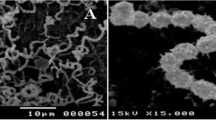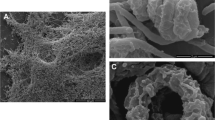Abstract
A rhizosphere isolate Streptomyces sp. CAH29 was found to possess potent antibacterial and antifungal activity against a variety of test organisms. Based on 16S ribosomal ribonucleic acid sequence homology studies, this strain was found to be similar to Streptomyces stramineus (gene sequence similarity 99 %). The major bioactive metabolite produced by Streptomyces sp. CAH29 isolate was extracted, purified andidentified by nuclear magnetic resonance as tetrangomycin. This known anthraquinone-exhibited antimicrobial activity against Staphylococcus aureus, Streptococcus pyogenes, methicillin resistant Staphylococcus aureus and Candida albicans with inhibition zones of 14, 10, 12 and 8 mm, respectively. Docking results demonstrate that tetrangomycin has a similar mode of action and a comparable docking score to bind to the dehydrosqualene synthase (CrtM) enzyme of methicillin resistant Staphylococcus aureus compared to the current inhibitor. Hence, this suggests that tetrangomycin has a potential to be used as an anti-methicillin resistant Staphylococcus aureus agent. Tetrangomycin also showed moderate free radical scavenging activity with 1,1-diphenyl-2-picryl-hydrazil. Tetrangomycin apparently decreased all of the studied cytokine (pro-inflammatory: interleukin 1B, interleukin 2, tumor necrosis factor and interleukin L6 and anti-inflammatory: interleukin 10) expression levels at IC50 concentrations in A459 (adenocarcinomic human alveolar basal epithelial) and LNCAP (human prostate adenocarcinoma) cell lines. In addition, it reduced Caspase 8 and 3 mRNA levels in LNCAP and A549 cells. This study describes for the first time novel in vitro immunosuppressive function of tetrangomycin by reducing the transcription of cytokine genes.







Similar content being viewed by others
References
Abdelfattah M, Kharel MK, Hitron JA, Baig I, Rohr J (2008) Isolation and structure elucidation of C glycosylangucycline type antibiotics from Streptomyces sp. KY 002. J Nat Prod 71:1569–1573
Appelbaum PC, Clark CL, Jacobs MR (1998) Antipeumococcal activities of levofloxacin and clarithromycin as determined by agar dilution, microdilution, E-test, and disk diffusion methodologies. J Clinic Microbiol 36:3579–3584
Dann M, Lefemine DV, Barbatschi F, Shu P, Kunstmann MP, Mitscher LA, Bohonos N (1965) Tetrangomycin, a new quinone antibiotic. Antimicrob Agents Chemother 5:832–835
Dewar MJS, Zoebisch EG, Healy EF, Stewart JJP (1985) Development and use of quantum mechanical molecular models. 76. AM1: A new general purpose quantum mechanical molecular model. J Am Chem Soc 107:3902–3909
Drautz H, Zähner H, Rohr J, Zeeck A (1986) Metabolic products of microorganisms. 234. Urdamycins, new angucycline antibiotices from Streptomyces fradiae; I. Isolation, characterization and biological properties. J Antibiot 12:1657–1669
Felsenstein J (1985) Confidence limits on phylogenies: An approach using the bootstrap. Evolution 39:783–791
Fguira LFB, Fotso S, Mehdi A, Mellouli L, Laatsch H (2004) Purification and structure elucidation of antifungal and antibacterial activities of newly isolated Streptomyces sp. strain US80. Res Microbiol 156:341–347
Fielder HP, Schimana J, Groth I, Submuth R, Beil W, Walker M, Zeeck A (2000) Simocyclinoes, novel cytostatic angucyclinoe antibiotics produced by Streptomyces antibioticus Tu 6040. J Antibiot 8:779–787
Frisch MJ, Trucks GW, Schlegel HB, Scuseria GE, Robb MA, Cheeseman JR, Montgomery Jr JA, Vreven T, Kudin KN, Burant JC, Millam JM, Iyengar SS, Tomasi J, Barone V, Mennucci B, Cossi M, Scalmani G, Rega N, Petersson GA, Nakatsuji H, Hada M, Ehara M, Toyota K, Fukuda R, Hasegawa J, Ishida M, Nakajima T, Honda Y, Kitao O, Nakai H, Klene M, Li X, Knox JE, Hratchian HP, Cross JB, Bakken V, Adamo C, Jaramillo J, Gomperts R, Stratmann RE, Yazyev O, Austin AJ, Cammi R, Pomelli C, Ochterski JW, Ayala PY, Morokuma K, Voth GA, Salvador P, Dannenberg JJ, Zakrzewski VG, Dapprich S, Daniels AD, Strain MC, Farkas O, Malick DK, Rabuck AD, Raghavachari K, Foresman JB, Ortiz JV, Cui Q, Baboul AG, Clifford S, Cioslowski J, Stefanov BB, Liu G, Liashenko A, Piskorz P, Komaromi I, Martin RL, Fox DJ, Keith T, Al-Laham MA, Peng CY, Nanayakkara A, Challacombe M, Gill PMW, Johnson B, Chen W, Wong MW, Gonzalez C, Pople JA (2004) Gaussian 03, Revision C.02. Gaussian, Inc., Wallingford CT
Keiser T, Bibb MJ, Buttner MJ, Chater KF, Hopwood DA (2000) General introduction to actinomycete biology: Proceedings of the practical streptomyces genetics. Norwich, UK.
Kimura M (1980) A simple method for estimating evolutionary rate of base substitutions through comparative studies of nucleotide sequences. J Mol Evol 16:111–120
Korynevska A, Heffeter P, Matselyukh B, Elbling L, Micksche M, Stoika R, Berger W (2007) Mechanisms underlying the anticancer activities of the angucycline landomycin E. Biochem Pharmacol 74:1713–1726
Krohn K, Rohr J (1997) Angucyclines: Total syntheses, new structures, and biosynthetic studies of an emerging new class of antibiotics. Top Curr Chem 188:127–195
Kuntsmann MP, Mitscher LA (1966) The structural characterization of tetrangomycin and tetrangulol. J Org Chem 31:2920–2925
Lang PT, Moustakas D, Brozell S, Carrascal N, Mukherjee S, Pegg S, Raha K, Shivakumar D, Rizzo R, Case D, Shoichet B, Kuntz I (2007) DOCK 6.1. University of California, San Francisco. http://dock.compbio.ucsf.edu/
Lucarini M, Pedrielli P, Pedulli GF, Valginigli L, Gigmes D, Tordo P (1999) Bond dissociation energies of the N-H bond and rate constants for the reaction with alkyl, alkoxyl, and peroxyl radicals of phenothiazines and related compounds. J Am Chem Soc 121:11546–11553
Martini N, Eloff JN (1998) The preliminary isolation of several antibacterial compounds from Combretum erythrophyllum (Combretaceae). J Ethnopharma 62:255–263
Oka M, Kamei H, Hamagishi Y, Tomita K, Miyaki T, Konishi M, Oki T (1990) Chemical and biological properties of rubiginone, a complex of new antibiotics with vincristine-cytotoxicity potentiating activity. J Antibiot 43:967–976
Patrikainen P, Kallio P, Metsä-Ketelä M (2012) Tailoring enzymes involved in the biosynthesis of angucyclines contain latent context-dependent catalytic activities. Chem Biol 19:647–655
Rohr J, Thiericke R (1992) Angucycline group antibiotics. Nat Prod Rep 9:103–137
Saadoun I, Muhanna A (2008) Optimal production condition, extraction, partial purification and characterization of inhibitory compounds produced by Streptomyces Ds-104 isolate against multi drug resistant Candida albicans. Curr Trends in Biotechnology and Pharmacy 2:402–420
Saitou N, Nei M (1987) The neighbor-joining method: A new method for reconstructing phylogenetic trees. Mol Biol Evol 4:406–425
Sakai K, Koyama N, Fukuda T, Mori Y, Onaka H, Tomoda H (2012) Search method for inhibitors of staphyloxanthin production by Methicillin-Resistant Staphylococcus aureus. Biol Pharm Bull 35:48–53
Shaaban KA, Srinivasan S, Kumar R, Damodaran C, Rohr J (2011) Landomycins P-W, cytotoxic angucyclines from Streptomyces cyanogenus S-136. J Nat Prod 74:2–11
Shimada K, Fujikawa K, Yahara K, Nakamura T (1992) Antioxidative properties of xanthone on the auto oxidation of soybean in cylcodextrin emulsion. J Agr Food Chem 40:945–948
Song Y, Liu CI, Lin FY, No JH, Hensler M, Liu YL, Jeng WY, Low J, Liu GY, Nizet V, Wang AHJ, Oldfield E (2009) Inhibition of staphyloxanthin virulence factor biosynthesis in Staphylococcus aureus: in vitro, in vivo, and crystallographic results. J Med Chem 52:3869–3880
Tamura K, Stecher G, Peterson D, Filipski A, Kumar S (2013) MEGA6: Molecular Evolutionary Genetics Analysis version 6.0. Mol Biol Evol 30:2725–2729
Thakur D, Yadav A, Gogoi BK, Bora TC (2007) Isolation and Screening of Streptomyces in soil of protected forest areas from the States of Assam and Tripura, India, for antimicrobial metabolites. Journal de Mycologie Medicale 17:242–249
Thomson RH (1996) Naturally Occurring Quinones. Blackie Academic & Professional, London
Tomasz A (1994) Multiple-antibiotic resistant pathogenic bacteria. N Eng. J Med 330:1247–1251
Won PJ, Song SB, Ryu SD, Lee C, Kim YB (2002) In Vitro bactericidal and anticancer activity of new metabolite, ARK42 isolated from Aspergillus repens K42. J Microbiol Biotechnol 12:1017–1021
Yılmaz Eİ, Yavuz M, Kızıl M (2008) Molecular characterization of rhizospheric soil streptomycetes isolated from indigenous Turkish plants and their antimicrobial activity. World J Microb Biot 24:1461–1470
Zhu L, Luzhetsky A, Luzhetska M, Mattingly C, Adams V, Bechthold A, Rohr J (2007) Generation of new landomycins with altered sacharide patterns through over-expression of the glycosyltransferase gene lanGT3 in the biosynthetic gene cluster of landomycin A in Streptomyces cyanogenus S-136. ChemBioChem 8:83–88
Acknowledgments
This study was supported by the Scientific and Technical Research Council of Turkey (TBAG 109T843) and Dicle University Research Foundation (DUBAP-09-FF-45) as well as the United States National Science Foundation (DEB-1136662). The authors would like to thank the staff of the Princeton University NMR and Mass Spectrometry facilities for experimental support.
Author information
Authors and Affiliations
Corresponding author
Ethics declarations
Conflict of interest
The authors declare that they have no conflict of interests.
Electronic supplementary material
Rights and permissions
About this article
Cite this article
Özakin, S., Davis, R.W., Umile, T.P. et al. The isolation of tetrangomycin from terrestrial Streptomyces sp. CAH29: evaluation of antioxidant, anticancer, and anti-MRSA activity. Med Chem Res 25, 2872–2881 (2016). https://doi.org/10.1007/s00044-016-1708-6
Received:
Accepted:
Published:
Issue Date:
DOI: https://doi.org/10.1007/s00044-016-1708-6




